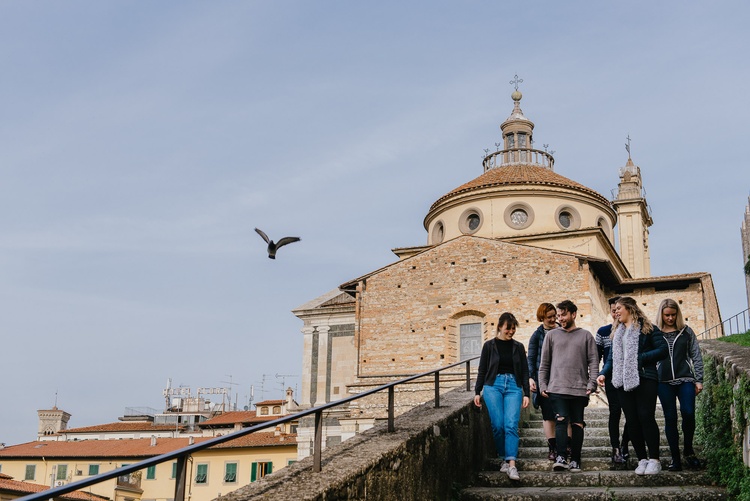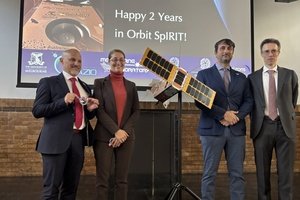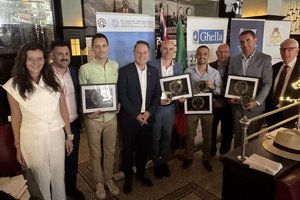Based in Palazzo Vaj, an 18th-century noble residence built on the medieval city walls, the university’s Italian campus continues to be a site for intellectual and cultural exchange, bringing students and academics together from around the world to meet, learn and collaborate, even at a time when international travel is limited.
We spoke with Cecilia Hewlett, Pro Vice-Chancellor (Prato Centre and Global Network Development) and Associate Dean (International) of the Faculty of Arts.
A historian specialising in the Renaissance, Hewlett played a key role in the centre’s establishment with its founding director, the late Emeritus Professor Bill Kent.
Monash University’s decision to open a branch in the Tuscan city was based on several factors: first of all, Professor Annamaria Pagliaro had strong contacts with local authorities (she was also the centre’s academic director from 2005 to 2008); secondly, Prato is situated in a strategic position in Italy and Europe.
In fact, many American and British universities have also established campuses in Tuscany.
However, Hewlett stressed that Monash University did not intend to replicate these universities’ models; rather, it wanted to create a supportive interdisciplinary site that allowed its researchers and students to access (and better understand) contemporary Europe.
Over the course of two decades, the Prato campus has helped Monash University to establish relationships and collaborations not only in the most obvious disciplines (history, language and fine arts) but in almost all faculties, including science, technology, law and engineering.
The courtyard of the Monash University Prato Centre, restored with the help of the late Carla Zampatti. (Photo: Monash University)
The collaborations extend beyond the academic sphere and into the corporate sector; for example, The Woolmark Company, the global authority on Merino wool, now operates in Prato, a city known for its thriving textile industry.
The Monash University Prato Centre also has strong connections with Italian entities, including the Prato campus of the University of Florence (PIN) and the local government.
The university has carried out extensive on-site research related to immigration and social cohesion in cities.
An example of this is a research initiative organised by Doctor Matteo Dutto, in collaboration with eight high schools in Prato, the National Geographic Society, the Scanlon Foundation and the Municipality.
A group of high school students speaking nine different languages spent a week together to organise a public pop-up exhibition that brought to life new perspectives on their city through photos, interactive storytelling, multi-video immersive installations, maps and data analysis.
The result of this “mapping” is available online, in Italian and English.
Thanks to a clear vision and strategy from the outset, the centre has continued to grow over the past 20 years, at least until the abrupt ending to 2020.
Prior to the coronavirus pandemic, around 800 Monash University students visited Palazzo Vaj every year and some 40 conferences and meetings were held between spring and autumn.
The length and nature of groups’ visits vary depending on the discipline, ranging from scientific programs to law courses, language and culture lessons, and internships in Italian schools for those undertaking teaching degrees.
Knowledge of the Italian language is not required as everything is taught in English, but all students have the chance to attend an extracurricular program that introduces them to the language and culture.
More and more young people of Italian heritage are taking the opportunity to go to Prato to study and discover their roots, also thanks to the scholarships made available every year by the Italian Australian Foundation.
The Italo-Australian community also played a role in funding the creation and development of the Monash University Prato Centre.
Rino Grollo and Diana Ruzzene Grollo were the first to fund the establishment of the centre, while the late Carla Zampatti contributed to the restoration of the Renaissance courtyard, a precious green space at the heart of the centre that is also open to the public.
Hewlett also acknowledged the contributions of Sir James Gobbo to the promotion of the centre.
While Prato and Tuscany are slowly coming back to life in the wake of the coronavirus pandemic, it is difficult to tell when the centre will once again be visited by Australians.
Despite the pandemic and the challenges that come with it, Monash University has confirmed its commitment to the centre.
“[The centre] is seen as a fundamental part of what we need to do as an institution to provide our students with these international experiences and with the skills that go along with them,” Hewlett said.
“In the post-COVID world, I think there’s that tendency of people in situations of crisis to close in and shut down.
“As an institution, we are completely committed to the opposite; its just the question of when.”
Hewlett said the interdisciplinary programs for undergraduate degrees will be restructured, with an engaging new training plan that will focus on issues such as migration and climate leadership.
In addition, the university is focusing on the creation of a research foundation that will work alongside the centre on many fronts, taking inspiration from Italian innovation.













